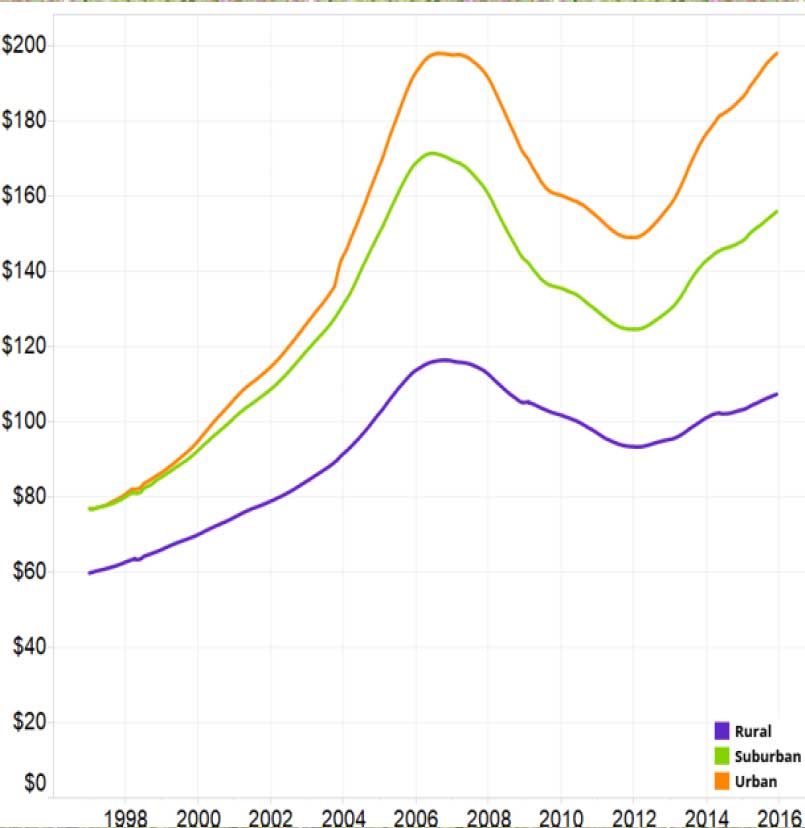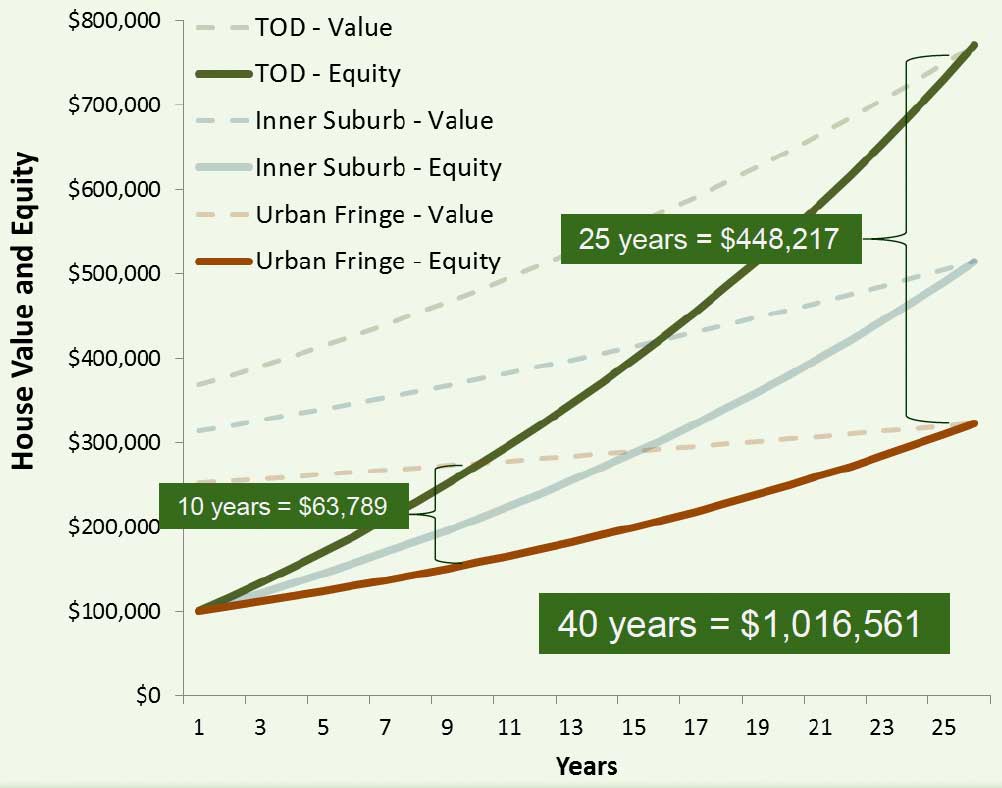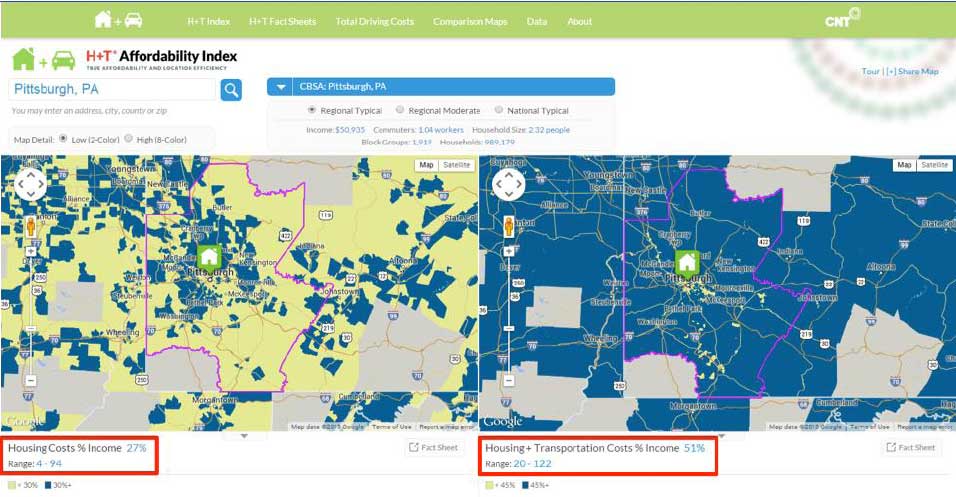Walkable urban neighborhoods tend to have more expensive housing but cheaper transport. By shifting spending from vehicles to housing a typical household can build a million dollars in additional equity by choosing a Smart Growth location.

Houses appreciate. Cars depreciate. That simple contrast is a key to building wealth over a lifetime, writes Todd Litman of the Victoria Transport Policy Institute.
Even though housing is more expensive in walkable, transit-rich neighborhoods, vehicle costs are substantially lower. Households in such neighborhoods shift their spending from transportation to housing. Over 40 years, this shift will add a million dollars of net worth to a typical household, Litman calculates.
That's enough to put children through college and/or to retire on—all from careful choice in housing location. There are plenty of other reasons to live in a walkable neighborhood—among them better health because exercise is built into the daily routine, less damage to the environment by cutting carbon emissions, and less time spent driving which frees up leisure. But the "million dollars" should really get people's attention.
"Urban fringe homes generally offer more space per dollar, and so appear to be better investments, but there are other economic factors to consider. By shifting household spending from transport to real estate, Smart Growth tends to increase household wealth, and by providing more affordable transport options it increases economic resilience," says Litman, in a report called Selling Smart Growth.
In the last generation, urban housing in North America has appreciated faster than suburban or rural housing. This price appreciation has added to the wealth of those who have invested in multimodal places. The appreciation is due to the rising demand for walkable urban places due to changing demographics, reduced crime, and the return of jobs to urban centers.

Housing appreciation in Urban, Suburban, and Rural locations over the last 20 years. Source: Todd Litman, Selling Smart Growth.
A typical $60,000/year household can afford $27,000 in combined housing and transportation expenses (that's 45 percent of income for the two expenses together). Choosing a home in a transit-oriented development (TOD) allows households to spend less money on transportation and more on housing. After ten years the TOD home builds $63,789 more equity, and after 25 years $448,217 more equity, than an urban fringe home. If, starting at age 25, a household always chooses TOD homes and invests the transport savings in real estate, they can retire at age 65 with approximately $1.8 million in equity, $1,016,561 more than if they purchased urban fringe houses with high transportation costs, as illustrated below.

The potential savings are demonstrated in the Housing & Transportation Affordability Index (H&T Index), created by the Center for Neighborhood Technology in Chicago. The Index makes the case that households should not spend more than 45 percent of their income for housing and transportation combined. This goal is best achieved in walkable neighborhoods, even though they tend to have higher housing cost per square foot.
 H&T Index of the Pittsburgh area shows affordability based on housing, left, and housing and transportation, right, in the Pittsburgh region. Distant areas are relatively less affordable.
H&T Index of the Pittsburgh area shows affordability based on housing, left, and housing and transportation, right, in the Pittsburgh region. Distant areas are relatively less affordable.
CNT founder Scott Bernstein notes that poor and working-class families are routinely given financial advice on how to get a car loan, but they are not educated on the financial advantages of reducing transportation expenses.
FULL STORY: The million-dollar neighborhood. Walkable mixed-use neighborhoods can help families build wealth.

Planetizen Federal Action Tracker
A weekly monitor of how Trump’s orders and actions are impacting planners and planning in America.

Chicago’s Ghost Rails
Just beneath the surface of the modern city lie the remnants of its expansive early 20th-century streetcar system.

Amtrak Cutting Jobs, Funding to High-Speed Rail
The agency plans to cut 10 percent of its workforce and has confirmed it will not fund new high-speed rail projects.

Ohio Forces Data Centers to Prepay for Power
Utilities are calling on states to hold data center operators responsible for new energy demands to prevent leaving consumers on the hook for their bills.

MARTA CEO Steps Down Amid Citizenship Concerns
MARTA’s board announced Thursday that its chief, who is from Canada, is resigning due to questions about his immigration status.

Silicon Valley ‘Bike Superhighway’ Awarded $14M State Grant
A Caltrans grant brings the 10-mile Central Bikeway project connecting Santa Clara and East San Jose closer to fruition.
Urban Design for Planners 1: Software Tools
This six-course series explores essential urban design concepts using open source software and equips planners with the tools they need to participate fully in the urban design process.
Planning for Universal Design
Learn the tools for implementing Universal Design in planning regulations.
Caltrans
City of Fort Worth
Mpact (founded as Rail~Volution)
City of Camden Redevelopment Agency
City of Astoria
City of Portland
City of Laramie



























